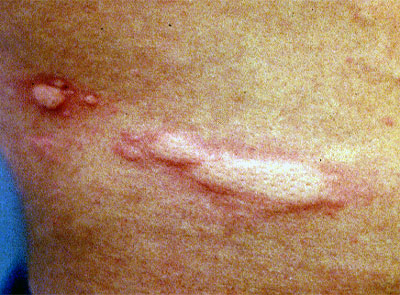|
|
|
Urticaria
Urticaria are wheals in the skin resulting from the release of histamine or other vasoactive substances.
There are many variants of urticaria including:
Acute urticaria:
Acute urticaria is an urticarial eruption which consists of multiple urticarial lesions, each lesion typically lasts for 8-24 hours, no longer. The complete eruption clears within 1-6 weeks usually.
Usually idiopathic, known causes include drugs and viral infection. Drugs that will exacerbate any underlying urticarial condition include the histamine releasers, such as members of the morphine-codeine group, and acetylsalicylic acid.
Chronic urticaria:
In some patients new urticarial lesions develop over a prolonged period of months to years. Chronic urticaria does not appear to be on a single agent allergen basis.
The cause is rarely discovered, but eventually the eruption clears.
Physical urticaria:
Trauma to the skin can release histamine from mast cells.
Physical urticaria includes dermographism, where pressure alone is enough to release histamine and cause an urticarial wheal at the site of trauma. Other causes of physical urticaria include heat and pressure, cold and sun.
Contact urticaria:
Contact urticaria is quite uncommon, and many patients that have it are atopic.
Contact with a specific allergen, or sometimes non allergen, can result in histamine release at the contact site.
Cholinergic urticaria:
Typical small red wheals occur in association with increased perspiration.
Exacerbating factors typically include exercise, hot showers or hot baths.
Treatment:
- Avoidance of exacerbating factors whenever possible.
- Type one allergy tests, scratch tests, can be dangerous in determining an etiology for acute urticaria. If the allergen is one of the test substances, general anaphylaxis can occur.
- All patients with urticaria must be advised of the dangers of morphine, codeine, and acetylsalicylic acid as histamine releasers.
- Exercise and high temperatures will worsen most urticaria.
- H2 antihistamines such as astemizole, cetirizine and terfenadine are frequently helpful.
- The older, more sedating antihistamines, such as hydroxyzine or diphenhydramine, are occasionally helpful, although the sedative effects can be problematic.
- Alternative therapies for physical urticaria include:
- H2 blockers and PUVA for dermographism
- Dapsone and sulfasalazine are reported to benefit delayed pressure urticaria
- Solar urticaria can be reduced by inducing tolerance to UVA
- Severe solar urticaria may be treated with cyclosporine
- Beta blockers may inhibit adrenergic urticaria
- Adding sodium bicarbonate to bath water helps 25% of patients with aquagenic urticaria.
- UVB may also be of some benefit to some individuals.

Back to Dermatology Glossary - U Index |
Back to Dermatology Glossary Index
|